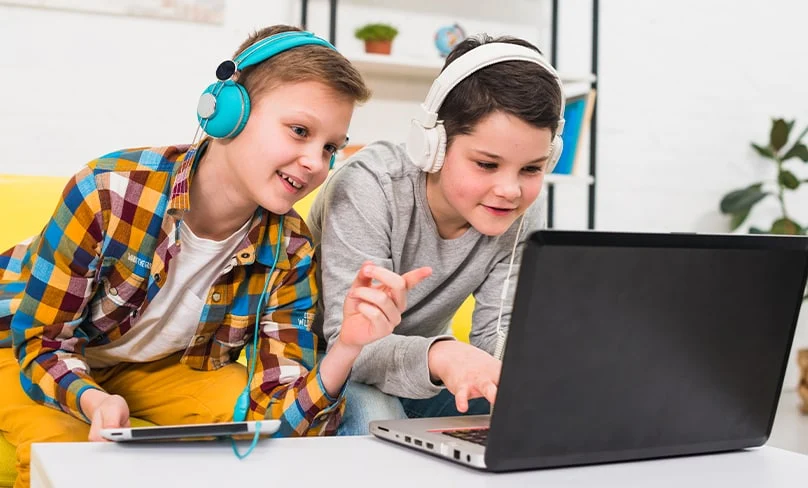The Right Way to Use Technology Effectively for Kids: A Guide for Parents
Jan 21, 2025
Read: Choosing After-School Programs That Best Fit Your Kids' and Teens' Future: A Parent's Guide to Matching Activities with Interests and Personality
Read: What is the Right Age to Start Coding?
Read: Why Every Teenager Should Learn Coding: Top Benefits for Teens and Parents
Read: What is the Most Popular After-School Activity?
Technology is an inseparable part of our daily lives, and children are increasingly exposed to it at a young age. While many parents may feel concerned about the impact of technology on their kids, it's important to understand that when used in the right way, technology can be a powerful tool for learning, creativity, and personal growth. The key is finding the balance between screen time and other activities, and ensuring that kids are using technology in a safe, productive, and positive way.
In this blog, we’ll explore the right ways to use technology effectively for kids, helping parents navigate the complexities of the digital age.
1. Set Healthy Boundaries for Screen Time
One of the biggest concerns parents have is screen time—the number of hours kids spend on devices like smartphones, tablets, and computers. While technology can be beneficial, excessive screen time can lead to problems like eye strain, lack of physical activity, and disrupted sleep.
How to Manage Screen Time:
Create a Schedule:
Set clear boundaries around when and how long kids can use technology. For instance, allocate time for educational apps, gaming, or social media use, but make sure to balance it with outdoor activities and family time. This helps ensure kids aren’t overexposed to screens and maintain a healthy routine.
Use Parental Control Apps:
Use tools like Google Family Link, Apple Screen Time, or Qustodio to monitor and manage screen time. These tools help you set time limits, track usage, and ensure kids are engaging with age-appropriate content, giving you more control over their digital activities.
Encourage Breaks:
Remind kids to take breaks every 30 minutes or so to rest their eyes and engage in other activities, like stretching or reading. Regular breaks help prevent eye strain and improve focus, promoting a healthier relationship with technology.
Read: Balancing Screen Time and Life: A Parent’s Approach to Teen Smartphone Use
2. Leverage Technology for Learning and Development
Technology has made educational resources more accessible than ever before. From interactive apps to online courses and educational games, there’s no shortage of digital tools that can enhance your child’s learning experience.
How to Use Technology for Learning:
Educational Apps:
There are a wealth of apps designed to foster skills in reading, math, science, and critical thinking. For younger children, consider apps like Khan Academy Kids, PBS Kids, or Starfall. For older kids, Duolingo for language learning and Prodigy Math are great options.
Online Courses and Tutorials:
Platforms like Khan Academy, Coursera, and Udemy offer free and paid courses on a wide range of topics. Encourage your child to explore courses that align with their interests, whether it’s coding, art, or history.
Interactive Learning Tools:
Tools like Minecraft Education Edition or Tynker (for coding) allow kids to learn through play, while also promoting problem-solving, creativity, and teamwork. By using these resources, kids can explore topics that go beyond the school curriculum, enhancing their knowledge and fostering a love for learning.
3. Encourage Creative Expression Through Digital Media
Technology isn’t just for consuming information—it can also be a platform for kids to express themselves creatively. Encouraging your child to engage with digital tools in creative ways can help them build new skills and develop a sense of accomplishment.
How to Foster Creativity with Technology:
Digital Art and Design:
Tools like Procreate, TinkerCAD, or Pixlr are fantastic for introducing kids to digital art, design, and 3D modeling. If your child has an interest in drawing or graphic design, these apps are excellent ways for them to experiment with their creativity and bring their artistic ideas to life.
Video Creation and Editing:
Platforms like iMovie, Adobe Premiere Rush, or Shotcut allow kids to create and edit their own videos. Whether they’re making short films, vlogs, or animation projects, video creation is a great way for kids to learn storytelling and technical skills while exploring visual communication.
Music Production:
Software like GarageBand or FL Studio allows kids to create their own music or experiment with sound design. Music production can help children develop an appreciation for rhythm, melody, and composition while enhancing their creativity and technical skills.
When kids engage with creative digital tools, they not only develop new skills but also learn how to communicate their ideas effectively in a digital world.
4. Teach Digital Literacy and Online Safety
In the digital age, digital literacy is just as important as traditional literacy. Kids need to learn how to navigate online spaces safely and responsibly. From understanding how to search for information online to recognizing misinformation and cyberbullying, digital literacy is essential for every child.
How to Teach Digital Literacy:
Introduce Critical Thinking: Teach kids how to assess online information critically. Help them understand the importance of verifying sources and checking facts before believing or sharing something they read.
Discuss Cybersecurity: Talk to your child about the importance of keeping personal information secure, using strong passwords, and recognizing potential online threats like phishing scams.
Promote Digital Etiquette: Encourage good online behavior. Teach your child about the importance of being respectful and kind online, and the consequences of cyberbullying.
Use Safe Platforms: When your child is ready to explore social media or online gaming, ensure they are using platforms designed for younger audiences, such as YouTube Kids or Discord for Kids. Set up strong privacy settings and talk to your child about what is appropriate to share, ensuring their online safety and promoting responsible digital habits.
By teaching kids the fundamentals of digital literacy, you help them navigate the online world safely and responsibly.
5. Use Technology to Build Social Connections
While technology is often seen as isolating, it can be a powerful tool for building social connections. Online gaming, social media, and communication apps allow kids to stay in touch with friends, collaborate on projects, and connect with peers who share similar interests.
How to Use Technology for Socializing:
Online Gaming:
Multiplayer games like Minecraft, Roblox, and Fortnite offer opportunities for kids to interact with friends in a virtual space. These games also promote collaboration, strategy, and teamwork, helping kids build social and communication skills while having fun.
Video Calls and Messaging:
Apps like Zoom, Skype, and WhatsApp allow kids to stay connected with family and friends, even when they can’t be physically together. Encourage them to video chat with grandparents, cousins, or classmates, making it easier for them to maintain relationships and stay socially engaged.
Collaborative Projects:
Platforms like Google Docs or Trello allow kids to work on school projects together, sharing ideas and collaborating in real-time. These tools help build teamwork and communication skills, teaching them how to work effectively in group settings.
Technology can serve as a bridge to help kids foster meaningful social connections, whether they’re learning together or playing with friends.
6. Promote Physical Activity with Tech
It’s important for kids to get plenty of physical activity, and surprisingly, technology can play a role in encouraging movement and exercise. From fitness apps to virtual exercise classes, there are many ways to integrate movement into a digital lifestyle.
How to Encourage Physical Activity with Technology:
Fitness Apps:
Apps like Sworkit, GoNoodle, or Just Dance offer fun ways for kids to get moving. These apps turn exercise into a game, making fitness feel like play and helping kids stay active in an engaging way.
Active Video Games:
Games like Ring Fit Adventure (for the Nintendo Switch) or Beat Saber (for VR) encourage kids to move while having fun. These games promote both physical activity and hand-eye coordination, making exercise enjoyable.
Outdoor Challenges:
Use apps like Geocaching or Pokémon Go to turn outdoor exploration into a tech-based treasure hunt, encouraging kids to be active while engaging with technology. These apps make walking, hiking, or exploring more exciting and active.
By combining physical activity with technology, kids can stay healthy and active without feeling like it’s a chore.
Harnessing Technology for Positive Growth
Technology, when used effectively, can be a powerful tool for learning, creativity, and personal growth. The key is ensuring that your child’s digital experience is balanced, engaging, and educational. By setting healthy boundaries, encouraging creativity, and teaching digital literacy, you can help your child thrive in the digital world.
With the right guidance, technology can be a positive force in your child’s life, helping them develop new skills, connect with others, and explore their passions. As a parent, it’s essential to stay involved, provide guidance, and monitor how technology is being used to ensure that it’s enhancing your child’s development rather than hindering it.
Read: Choosing After-School Programs That Best Fit Your Kids' and Teens' Future: A Parent's Guide to Matching Activities with Interests and Personality
Read: Why Every Teenager Should Learn Coding: Top Benefits for Teens and Parents
Read: What is the Most Popular After-School Activity?
Pinecone Coding Academy's Kids Coding Program
At Pinecone Coding Academy, we are passionate about making coding accessible and enjoyable for kids aged 8-17. Our program is designed to inspire and equip young learners with the skills they need to thrive in the digital world.
Click here to discover a coding class that matches your teen's or child's interests.
What We Offer:
Engaging Curriculum: Our courses introduce students to popular programming languages like Python, JavaScript, and HTML/CSS, laying a strong foundation for future learning.
Hands-On Projects: Students participate in project-based learning, creating real applications that they can showcase, from interactive games to personal websites.
Mentorship and Support: Our experienced instructors provide guidance, helping students navigate challenges and discover their coding potential.
Community Connection: By joining Pinecone, students become part of a vibrant community of peers, fostering collaboration and friendship as they learn.
Try a Free Session!
If your child is curious about coding, Pinecone Coding Academy offers a free introductory session for kids aged 8-17. This is a fantastic opportunity to explore programming in a fun and engaging way.
More blogs







